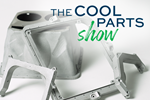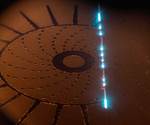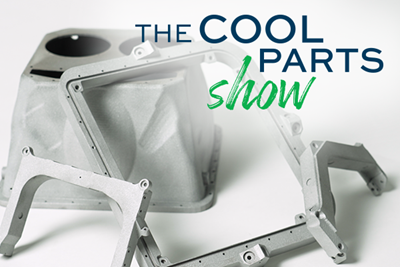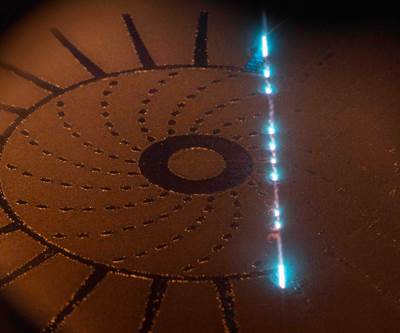Electron beam melting (EBM) has become a reliable production choice for end-use components ranging from jet engine parts to medical implants. The metal 3D printing method often fills the niche where a laser powder bed fusion (PBF) process might build too much residual stress into a part or require inordinate amounts of support structures. But EBM also has its limits, some of which are tied to the very mechanism by which it works.
The electron beam inside the 3D printer functions like a particle accelerator, attracting electrons from a filament and firing them onto the powder surface to fuse the particles together. But these electrons can also create problematic charged powder particles, something Wayland Additive sees as the Achilles’ heel of the process. The UK-based company has recently introduced an electron beam melting variant to the market that circumvents this shortcoming. Its NeuBeam process still relies on an electron beam as its energy source, but steps taken to prevent charged powder particles have led to process efficiencies over conventional EBM metal 3D printing.
Electron Beam Melting without Layer Pre-Sintering
A conventional electron beam melting process happens under vacuum at a high operating temperature. Each layer of powder is “pre-sintered” before the electron beam selectively fuses the geometry of the part; completed builds emerge from the printer packed into a cake of semi-sintered powder. This “hot-bed” metal 3D printing approach provides support for parts during printing, helps avoid the creation of stresses, and allows EBM parts to resist microcracking and other defects better than laser-based powder bed fusion prints.
The pre-sintering step has not been a choice, however, but a necessity for EBM. If the electrons were to hit a loose powder bed, a surface charge could build up causing the particles to repel each other, disperse and perhaps even create a smoke event that forces the build to terminate. Many metal powders also form an oxidation layer on the exterior of the particles, which is conductive; pre-sintering is necessary to hold the powder in place and ground this conductive layer.
Wayland Additive’s NeuBeam (for “neutral beam”) process avoids these challenges by neutralizing the surface charge that accumulates in the powder bed. When the risks associated with this charging are removed, electron beam melting can look much more like laser sintering. (In fact, Wayland describes the process as a “third way” of metal 3D printing, one that sits between EBM and laser sintering.)
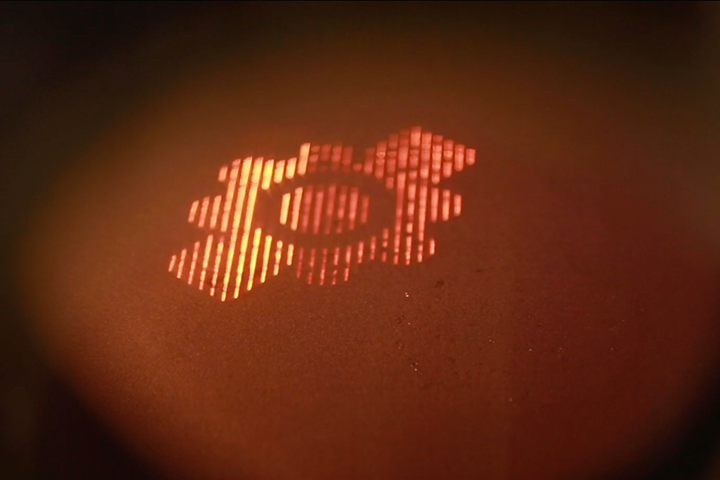
As a “hot part” rather than “hot bed” process, NeuBeam 3D printing requires pre-sintering only of the part’s cross-section, shortening build times. Unused powder stays loose which also simplifies postprocessing. Photos: Wayland Additive
NeuBeam 3D printing takes place at temperatures above annealing but below sintering for the material used — meaning that the unused powder stays loose. The lack of a powder “cake” widens EBM’s geometric capabilities and dramatically simplifies part unpacking, powder removal and postprocessing. And because the process still takes place under vacuum, oxidation of the unused powder is minimized, making it possible to recycle all or nearly all of the leftover material for future prints.
But although NeuBeam is not a “hot bed” process, users still benefit from its “hot part” 3D printing strategy. Each layer cross-section is pre-sintered before melting, rather than the entire bed; this technique allows for time savings and productivity improvements while retaining EBM’s resistance to distortion and residual stresses. Parts cannot be entirely free-floating in the bed as with conventional electron beam melting, and supports may still be necessary for heat extraction from overhangs, but anchor points do not need to be substantial and can be designed for easy removal, the company says. Users also have the option to pre-sinter regions of the powder bed if desired. Like conventional EBM, NeuBeam parts typically do not require heat treat following printing, simplifying the additive manufacturing workflow.

Neutralized Process Supports New Materials
The NeuBeam process will be available through the Calibur3 3D printer, which Wayland Additive expects to begin shipping in the fall of 2021. The initial machine launch will accommodate a maximum component size of 300 by 300 by 450 mm. The Calibur4 planned for later release will have a maximum size of 450 mm in all dimensions; existing Calibur3 machines will be upgradable in the field. In-process monitoring through structured light scanning, electron imaging and infrared cameras makes it possible to detect defects and track quality assurance data across the entire build. Open parameters support process control tailored to the material at hand.
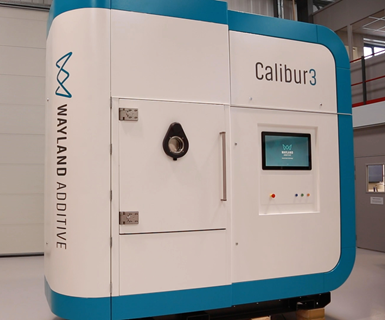
The Calibur3 is expected to beginning shipping from the UK in September or October 2021.
It’s this materials openness that Wayland Additive believes will help drive additive manufacturing forward. Thus far titanium alloys and CM 247 have been verified for the NeuBeam process, but validation is ongoing. The neutralized printing environment can support finer powders than have previously been used in electron beam melting (likely improving surface finish for these parts), and could also open the door to new metal 3D printing materials. The company anticipates that refractory metals, highly reflective alloys, and materials not currently compatible with other EBM or laser powder bed fusion processes could all be compatible with this platform.
Related Content
VulcanForms Is Forging a New Model for Large-Scale Production (and It's More Than 3D Printing)
The MIT spinout leverages proprietary high-power laser powder bed fusion alongside machining in the context of digitized, cost-effective and “maniacally focused” production.
Read More10 Important Developments in Additive Manufacturing Seen at Formnext 2022 (Includes Video)
The leading trade show dedicated to the advance of industrial 3D printing returned to the scale and energy not seen since before the pandemic. More ceramics, fewer supports structures and finding opportunities in wavelengths — these are just some of the AM advances notable at the show this year.
Read MoreWhat is Powder Bed Fusion 3D Printing?
Whether in metal or polymer, with a laser or an electron beam, powder bed fusion (PBF) is one of the most widely used 3D printing techniques.
Read MoreHow to Build 10,000+ Shot Molds in Hours
Rapid tooling isn’t so rapid when it takes days to 3D print a metal mold, and then you still must machine it to reach the necessary tolerances. With Nexa3D’s polymer process you can print a mold in hours that is prototype or production ready and can last for more than 10,000 shots.
Read MoreRead Next
Freemelt Offers an Open-Source Toolbox for Material Development
Swedish startup Freemelt believes collaboration will be a way forward for metal additive manufacturing. Its Freemelt One electron beam melting system for R&D supports this open-source philosophy.
Read More3D Printed Parts on the Mars Perseverance Rover: The Cool Parts Show #23
The Perseverance parts made through additive manufacturing are extreme examples of lightweighting. We have replicas of the 3D printed parts that were sent to Mars.
Read MoreWayland Additive's NeuBeam PBF Process Creates Parts Free of Residual Stresses
Wayland Additive has been working on the development of an entirely new powder bed fusion (PBF) process for metal AM called NeuBeam.
Read More

.jpg;width=70;height=70;mode=crop)

